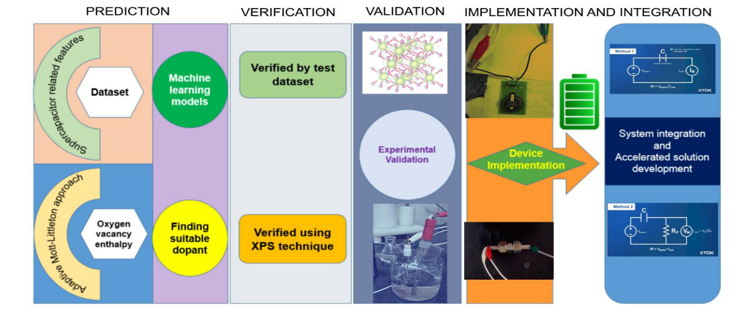Video Article Open Access
From Computational Design to Systems Implementation: Towards Fading-Free Oxynitride Materials for Electrochemical Energy Storage
Tiju Thomas
Department of Metallurgical and Materials Engineering, IIT Madras, Adyar, Chennai, Tamil Nadu, 600036, India
Vid. Proc. Adv. Mater., Volume 3, Article ID 2208303 (2022)
DOI: 10.5185/vpoam.2022.08303
Publication Date (Web): 21 Nov 2022
Copyright © IAAM
Graphical Abstract

Abstract
Supercapacitors hold much promise, as electrochemical devices in terms of both energy and power densities. However, their capacitance fading over cycles (often times less than 10k) is a serious impediment for their penetration into the consumer electronics segment. Recently we demonstrated that through a materials informatics driven approach, cerium oxynitrides could offer a capacitance fading of less than 10% over 100000 cycles. This was thereafter proven experimentally. The precise device specification are as follows: 194 Fg-1 at 2 Ag-1 current density with ~100% specific capacitance retention over 10k cycles. This material design-based discovery has paved way for developing confidence in a new paradigm for materials (composition) selection and implementation. With regards to implementation, the device is currently being put into circuit to minimize the leakage current (in µA range), thereby allowing for development of a readily usable two-electrode, 12 V module with technical specifications that address a clear market gap (with a series resistance in the mΩ range and competitive stability till ~100, 000 cycles).
The lecture will end with brief overview of two more cases where in computational design and quasi-chemistry drove materials selection and implementation in the clean energy-water interface. This will show that the materials design to system implementation paradigm we adopt in our group in IIT Madras is likely to pave way for accelerated development of solutions in the clean water-energy interface.
Keywords
Materials informatics; oxynitrides; energy storage; energy-water interface; system implementation.
Acknowledgement
Tiju Thomas acknowledges Indian Institute of Technology Madras and Department of Science and Technology, Government of Indian for financial support. It may be noted that for this lecture, I will rely on the work of graduate students Sourav Ghosh, U Naveen Kumar and Kousika Anbalgam, and project officer Sandeep Kumar. Sourav is co-advised by Dr. GR Rao. I am also grateful to my colleague Dr. CR Jeevandoss for support on system integration. Several undergraduate students have interned with me and aided me in many ways to carry out this work.
References
1. Ghosh S, Rao GR, Tiju Thomas. Energy Storage Materials, 2021, 40, 426.
2. Kumar UN, Ramavath JN, Ghosh S, Kothandaraman R, Tiju Thomas, Batteries & Supercaps, 2020, 3(8), 780.
3. Ghosh, S., Anbalagan, K., Kumar, U.N., Tiju Thomas, Rao, G.R., Applied Materials Today, 2020, 21, p.100872.
4. Ghosh, S., Rao, G.R. and Tiju Thomas, ChemistrySelect, 2020, 5(5), 16281639.
5. Ghosh S, Priyanga GS, Kumar UN, Gangavarapu RR, Jeevandoss CR, Tiju Thomas, IOP InECS Meeting, 2021, 8, 2080.
Biography
Tiju Thomas is currently an Associate Professor in the Department of Metallurgical and Materials Engineering, Indian Institute of Technology Madras, India. He is also the inter-domain coordinator of DST Solar Energy Harnessing Centre (DSEHC), IIT Madras.
He holds a doctorate in electrophysics from Cornell University (Ithaca, NY. the USA). He has advanced degrees in electrophysics, applied physics, and electrical engineering. After postdoctoral stints that involved both academia (University of Toronto – Optical Sciences and Chemistry, Memorial University - Physics) and industry (Lumentra Inc.). He is a faculty in Indian Institute of Technology Madras currently.
Dr. Thomas’ current research interests lie broadly in the nanomaterials challenges at the energy-environment nexus. He has authored/co-authored more than 150 papers in a variety of topics related to functional materials, holds 8 patents, and runs a productive (nano)materials engineering research group with eighteen graduate students, who are advised or coadvised by him. He runs several funded programs through his laboratory at IIT Madras. He particularly enjoys international and inter-disciplinary collaborations built around technologies for sustainability (e.g., electrochemical energy storage, water remediation and clean hydrogen). (Ref: https://sites.google.com/view/tiju-thomas).
Video Proceedings of Advanced Materials

Upcoming Congress



